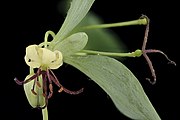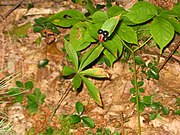
Trillium is a genus of about fifty flowering plant species in the family Melanthiaceae. Trillium species are native to temperate regions of North America and Asia, with the greatest diversity of species found in the southern Appalachian Mountains in the southeastern United States.
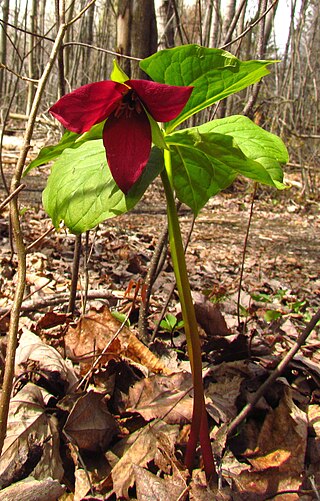
Trillium erectum, the red trillium, also known as wake robin, purple trillium, bethroot, or stinking benjamin, is a species of flowering plant in the family Melanthiaceae. The plant takes its common name "wake robin" by analogy with the European robin, which has a red breast heralding spring. Likewise Trillium erectum is a spring ephemeral plant whose life-cycle is synchronized with that of the forests in which it lives. It is native to the eastern United States and eastern Canada from northern Georgia to Quebec and New Brunswick.

The lily family, Liliaceae, consists of about 15 genera and 610 species of flowering plants within the order Liliales. They are monocotyledonous, perennial, herbaceous, often bulbous geophytes. Plants in this family have evolved with a fair amount of morphological diversity despite genetic similarity. Common characteristics include large flowers with parts arranged in threes: with six colored or patterned petaloid tepals arranged in two whorls, six stamens and a superior ovary. The leaves are linear in shape, with their veins usually arranged parallel to the edges, single and arranged alternating on the stem, or in a rosette at the base. Most species are grown from bulbs, although some have rhizomes. First described in 1789, the lily family became a paraphyletic "catch-all" (wastebasket) group of lilioid monocots that did not fit into other families and included a great number of genera now included in other families and in some cases in other orders. Consequently, many sources and descriptions labelled "Liliaceae" deal with the broader sense of the family.
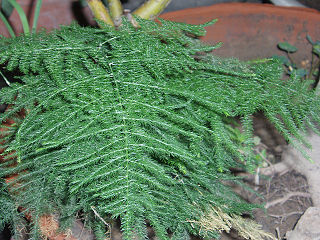
Asparagus is a genus of flowering plants in the family Asparagaceae, subfamily Asparagoideae. It comprises up to 300 species. Most are evergreen long-lived perennial plants growing from the understory as lianas, bushes or climbing plants. The best-known species is the edible Asparagus officinalis, commonly referred to as just asparagus. Some other members of the genus, such as Asparagus densiflorus, are grown as ornamental plants.
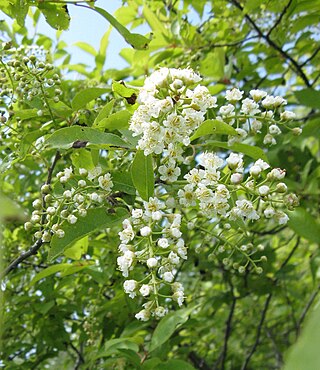
Prunus virginiana, commonly called bitter-berry, chokecherry, Virginia bird cherry, and western chokecherry, is a species of bird cherry native to North America.

Clintonia is a genus of flowering plants in the lily family Liliaceae. Plants of the genus are distributed across the temperate regions of North America and eastern Asia, in the mesic understory of deciduous or coniferous forests. The genus, first described by Constantine Samuel Rafinesque in 1818, was named for DeWitt Clinton (1769–1828), a naturalist and politician from the U.S. state of New York. For this reason, plants of the genus are commonly known as Clinton's lily. The common name bluebead refer to the distinctive fruit of members of the genus. Since fruit color varies somewhat across species, the common name bead lily is used as well.
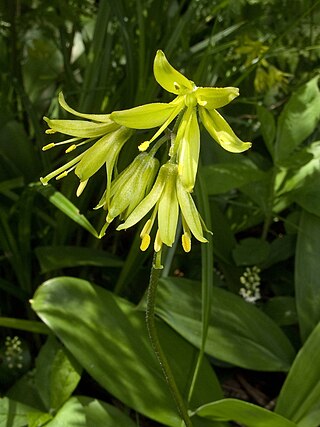
Clintonia borealis is a species of flowering plant in the lily family Liliaceae. The specific epithet borealis means "of the north," which alludes to the fact that the species tends to thrive in the boreal forests of eastern Canada and northeastern United States.

Maianthemum racemosum, the treacleberry, feathery false lily of the valley, false Solomon's seal, Solomon's plume or false spikenard, is a species of flowering plant native to North America. It is a common, widespread plant with numerous common names and synonyms, known from every US state except Hawaii, and from every Canadian province and territory, as well as from Mexico.

Trillium luteum, the yellow trillium or yellow wakerobin, is a species of flowering plant in the bunchflower family Melanthiaceae. It is a member of the Trillium cuneatum complex, a closely-related group of sessile-flowered trilliums. The species is endemic to the southeastern United States, especially in and around the Great Smoky Mountains of eastern Tennessee and western North Carolina.

Trillium flexipes, known as the nodding wakerobin, bent trillium, or drooping trillium, is a species of flowering plant in the family Melanthiaceae. It is found from Minnesota to Ohio, south to Tennessee, with isolated populations in New York, Pennsylvania, Alabama, and other states. It is an endangered species in Ontario and possibly extirpated in North Carolina.

Asparagus asparagoides, commonly known as bridal creeper, bridal-veil creeper, gnarboola, smilax or smilax asparagus, is a herbaceous climbing plant of the family Asparagaceae native to eastern and southern Africa. Sometimes grown as an ornamental plant, it has become a serious environmental weed in Australia and New Zealand.

Trillium cuneatum, the little sweet betsy, also known as whip-poor-will flower, large toadshade, purple toadshade, and bloody butcher, is a species of flowering plant in the family Melanthiaceae. It is a member of the Trillium cuneatum complex, a subgroup of the sessile-flowered trilliums. It is native to the southeastern United States but is especially common in a region that extends from southern Kentucky through central Tennessee to northern Alabama. In its native habitat, this perennial plant flowers from early March to late April. It is the largest of the eastern sessile-flowered trilliums.
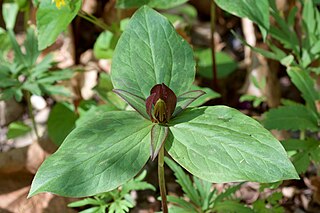
Trillium sessile is a species of flowering plant in the bunchflower family Melanthiaceae. The specific epithet sessile means "attached without a distinct stalk", an apparent reference to its stalkless flower. It is commonly known as toadshade or toad trillium. It is also called sessile trillium or sessile-flowered wake-robin, however it is not the only member of the genus with a sessile flower.
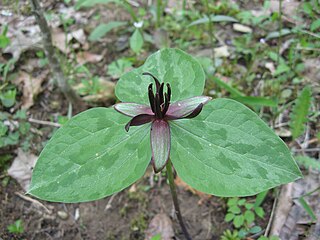
Trillium stamineum, the twisted trillium, also known as the Blue Ridge wakerobin, is a species of flowering plant in the family Melanthiaceae. It is native to the southeastern United States, in Alabama, Mississippi and Tennessee. Its natural habitat is calcareous woodlands.

Trillium sulcatum is a species of flowering plant in the bunchflower family Melanthiaceae. It is a member of the Erectum group, a group of species typified by Trillium erectum. The specific name sulcatum means "furrowed, grooved, or sulcate", which describes the tips of the sepals. It is most abundant on the Cumberland Plateau in central Tennessee and eastern Kentucky where it blooms in April and May. The species is commonly known as the southern red trillium or furrowed wakerobin.

Trillium albidum is a species of flowering plant in the bunchflower family Melanthiaceae. It is the only trillium characterized by a stalkless white flower. The species is endemic to the western United States, ranging from central California through Oregon to southwestern Washington. In the San Francisco Bay Area, it is often confused with a white-flowered form of Trillium chloropetalum. In northern Oregon and southwestern Washington, it has a smaller, less conspicuous flower.

Trillium petiolatum, the Idaho trillium, also known as the long-petioled trillium or round-leaved trillium, is a species of flowering plant in the family Melanthiaceae. It is native to the northwestern United States, in Idaho, Oregon, and Washington. The type specimen for this species was gathered by Meriwether Lewis in 1806 along the Clearwater River during the return trip of the Lewis and Clark Expedition.
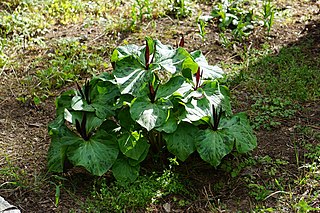
Trillium angustipetalum, with the common name is narrowpetal wakerobin, is a species of Trillium, plants which may be included within the Liliaceae or the newer family Melanthiaceae.
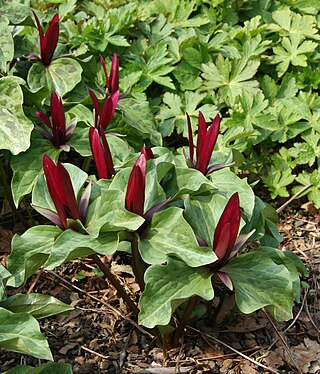
Trillium kurabayashii is a species of flowering plant in the bunchflower family Melanthiaceae. The species is endemic to the western United States, occurring in extreme southwestern Oregon, northwestern California, and the Sierra Nevada of northern California. It was first described by John Daniel Freeman in 1975. The specific epithet kurabayashii honors Masataka Kurabayashi, a Japanese cytologist and population geneticist who first postulated the taxon’s existence. It is commonly known as the giant purple wakerobin, a reference to its conspicuously large, dark purple-red flower, one of the largest of any sessile-flowered trillium.
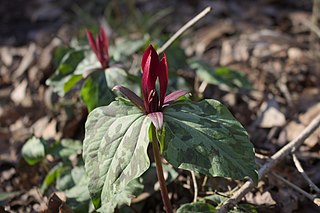
Trillium maculatum, the spotted wakerobin or spotted trillium, is a species of flowering plant in the family Melanthiaceae. It is a member of the Trillium cuneatum complex, a closely-related group of sessile-flowered trilliums. The species is endemic to the southeastern United States, ranging across Alabama, Georgia, South Carolina, and northern Florida.




